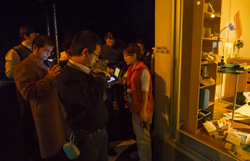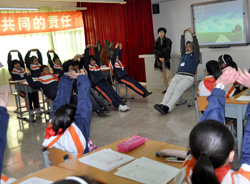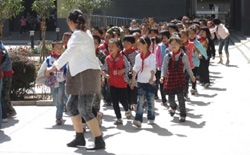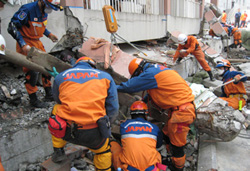Home > Highlighting JAPAN > Highlighting Japan MARCH 2013 > INTERNATIONAL COOPERATION FOR DISASTER REDUCTION
Highlighting JAPAN
COVER STORY: LESSONS FROM DISASTERS
INTERNATIONAL COOPERATION
FOR DISASTER REDUCTION
Japan has been striving to use the expertise it has developed from its own long experience with natural disasters to help other countries, particularly in developing countries, better prevent and recover from similar disasters. Osamu Sawaji of the Japan Journal reports on two such examples.

Participants on the "Tokyo earthquake simulation 72-hour tour" at the disaster prevention experience facility in Tokyo Rinkai Disaster Prevention Park. "72 hours" refers to the time from when an earthquake strikes to when organized rescue operations begin. The handheld game consoles have English capability.
Credit: MASATOSHI SAKAMOTO
The Building Research Institute, International Institute of Seismology and Earthquake Engineering (IISEE) in Tsukuba, Ibaraki Prefecture, on the outskirts of Tokyo, in cooperation with the Japan International Cooperation Agency (JICA) and the National Graduate Institute for Policy Studies, provides training courses to researchers and engineers from developing countries to mitigate earthquake disasters. These courses have been running since 1960, and to date have been completed by 1,580 participants from ninety-eight countries. After returning to their native countries, many graduates have become government ministers, research institute directors, or university professors.
"This is the only institute in the world that runs regular courses for such a large number of people from so many different countries," says Shoichi Ando, director of the IISEE. "The lecturers are well informed about current conditions in developing countries, and use this knowledge to ensure that their teaching has relevance for each country." The focus of the IISEE training is International Training in Seismology and Earthquake Engineering. The program is divided into three parts: Seismology Course, Earthquake Engineering Course, and Tsunami Disaster Mitigation Course, and its duration is around one year. Participants can obtain a master's degree.
In addition, the China Seismic Building Course has been held since 2009 for Chinese structural technology specialists, in response to the 2008 Sichuan earthquake.
The 53rd International Seismology and Earthquake Engineering Training Course started in October last year. There are twenty-one participants from fifteen countries including China, Indonesia, Turkey and Nicaragua. The majority are aged between twenty and forty and hold positions of responsibility for earthquake disaster mitigation in their respective countries.

Engaging in discussion at the Building Research Institute in Tsukuba, Ibaraki Prefecture: Joseph Nyago from Uganda (left), Nazeli Galstyan Grisha from Armenia (center) and Mauricio Reyes Gallrodo from Chile.
Credit: MASATOSHI SAKAMOTO
"International seismology and earthquake engineering training is excellent because we learn both theory and practice. Observing a disaster area, actually verifying with my own eyes the theoretical knowledge of disaster damage, for example the extent of the damage to a building caused by the force of the tsunami, was one of the most effective methods to learn," says Nazeli Galstyan Grisha, a participant from the Ministry of Emergency Situations Western Survey for Seismic Protection in Armenia, to the west of the Caspian Sea. "After observing the disaster area, I felt strongly that I need to do my best to acquire knowledge about earthquake engineering. It gave me a renewed sense of the importance of earthquake engineering in saving people's lives."
In February this year, participants observed the Tokyo Rinkai Disaster Prevention Park. The Disaster Prevention Park has an open park area that acts as a heliport and a base camp for personnel dispatched to provide rescue and recovery services in a time of disaster. Also, a Disaster Prevention Base and Disaster Prevention Experience-Learning Facility have been built in the administrative building inside the park. The emergency response headquarters for the government and relevant prefectures is set up in the Disaster Prevention Base in a time of disaster.
The "Tokyo earthquake simulation 72-hour tour" at the Disaster Prevention Experience-Learning Facility allows you to experience the flow of events from when an earthquake strikes through to evacuation, while responding to a quiz using a handheld game console. There is also a realistic life-size diorama that recreates a built-up area that has been struck by an earthquake.
"These facilities are amazing, the scale of them, the realistic nature of the diorama, the idea of using video games. My country absolutely needs this kind of facility," says Professor Mauricio Reyes Gallrodo of the University of Valparaiso in Chile, South America. "I realized how important high quality education on natural disasters is for disaster mitigation."
At IISEE, which is the base for training, lectures and discussions are held using the latest data. Earthquake and tsunami data as well as data on damage to buildings from the Great East Japan Earthquake are already being used in the training course. The course runs for one year, but for the last three months participants carry out research on a self-chosen topic.
"On this course you can meet people from many different countries and cultures. Virtually the world is here," says Joseph Nyago of the Ministry of Energy and Mineral Development of Uganda in East Africa. "When I return to my native country I would like to use the knowledge and experience that I acquired in Japan to advance my government about disaster mitigation measures. For example, Uganda is severely affected by landslides. I want to make a commitment to ensure that the government takes appropriate measures to deal with this problem."

Learning methods of relaxation from a Japanese expert
Credit: COURTESY OF JICA
The magnitude-8.0 Great Sichuan Earthquake that hit China's Sichuan Province on May 12, 2008 was a disaster that affected around 46 million people, with the number of deceased and missing exceeding 80,000. Children accounted for about 10% of those because over 7,000 elementary and junior high school buildings collapsed. Immediately after the earthquake, Japan rapidly dispatched a Japan Disaster Relief Team to the affected areas and carried out relief activities.
Earthquakes harm many people not only physically but also psychologically, and many cases of alcoholism, depression, post-traumatic stress disorder (PTSD) and other symptoms have been reported in their wake.
"Psychological disorders caused by disasters and accidents could occur in anyone. Many people recover naturally, but recovery delays or problems can surface over time due to loss of family and friends, changes in living environments, job changes and other reasons," says Ryotaro Oda of the China Office of the Japan International Cooperation Agency (JICA). "When the Great Hanshin-Awaji Earthquake struck in 1995, the greatest number of elementary school children requiring psychological care was four years after the disaster. For this reason, an organization and human resources development that enable continuous care over the medium and long terms are important."

An evacuation drill at an elementary school in Sichuan Province
Credit: COURTESY OF JICA
Experts from Japan and China have collaborated on human resources development, offering training to doctors, teachers, counselors and others both in China and Japan. Support organizations rooted in communities have also been established. One example is a service, provided at community centers, that combines traditional medicine such as acupuncture and massage together with counseling. Advocacy activities are also being conducted through events in order to reduce prejudice and resistance to psychological support.
"In China, there was insufficient knowledge of appropriate ways to handle psychological support. Many organizations provided relief aid immediately after the earthquake, but psychological support was in some ways provided inappropriately," Oda says. "In the Psychosocial Support Project, we have applied experiences and lessons learned after the Great Hanshin-Awaji Earthquake and kept these in mind to reach people who require support."

Members of a Japan Disaster Relief Team active in an area affected by the Great Sichuan Earthquake in May, 2008
Credit: COURTESY OF JICA
There were also cases of caregivers suffering from trauma, because they were also victims, while there were others suffering from burnout syndrome because they had dedicated themselves to caring for others too much. For this reason, support has been provided to caregivers by giving lectures on stress management.
After the Great Hanshin-Awaji Earthquake, disaster prevention education to prepare for future disasters has become widespread. In itself such education helps children psychologically, because it contributes to a feeling of safety. So it was decided to adopt evacuation drills and other forms of disaster prevention education at schools in the Psychosocial Support Project for the Sichuan Earthquake as well; a step that was not often previously taken in China.
The Great East Japan Earthquake struck in March 2011 while the Psychosocial Support Project was underway in China. Following the disaster, children in Sichuan sent messages of encouragement for those in Tohoku through JICA's China Office; messages such as "Our hearts are one even though we are far apart," and "Let's be courageous and hang on so we can keep up the fight against these disasters." As a part of the Psychosocial Support Project training, Chinese participants have visited affected areas in Tohoku and held discussions with people involved, while Japanese experts have introduced their psychological support activities in Tohoku.
"The Psychosocial Support Project is becoming a platform for mutual learning on the path toward recovery for the people affected in the Great Hanshin-Awaji Earthquake, Great Sichuan Earthquake and Great East Japan Earthquake," Oda says. "China is a disaster-prone country like Japan. Human resources cultivated in this project may be helps other disaster-affected areas in the future."
© 2009 Cabinet Office, Government of Japan






